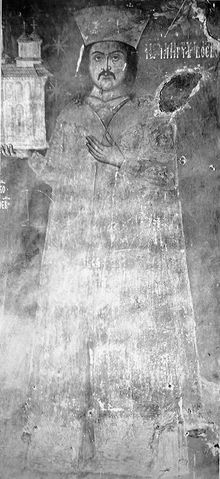- Mircea the Shepherd
-
Mircea the Shepherd (died 25 September 1559) was the Prince (Voivode) of Wallachia three times: January 1545 (he entered Bucharest on 17 March)–16 November 1552; May 1553–28 February 1554 (leaving Bucharest that March); and January 1558–21 September 1559.
Biography
He was the fifth son of Radu cel Mare. His baptismal name was Dumitru and he married Chiajna, the daughter of Petru Rareş, whose name was in fact Ana. He was probably called the Shepherd because he bought sheep for the Istanbul markets before ascending the throne.
The Ottoman Empire (Wallachia's suzerain) named him ruler in January 1545 in place of his stepbrother Radu Paisie and he entered Bucharest on 17 March 1545, ascending the throne on that day. Through his first decree of privilege, of 25 March 1545, he maintained in their functions and even promoted four high officials of his predecessor. A chronicle relates that two weeks after his installation, he ordered that a number of boyars be killed, including Coadă the vornic (internal affairs minister), Radul the comis, Stroe the spătar (second-in-command of the military), and Vintilă, also a comis. The chronicle also mentions that they were tortured so that they would reveal where the money and jewels were hidden, so that these could be poured into the treasury. Following this massacre, some of the wealthiest boyars and the relatives of those killed went into exile in Transylvania and Hungary, where they came together and tried twice to depose him from the throne.
The first attempt came at the Battle of Periş, on August 24, 1546, when the host of boyars in exile was attacked by surprise and decimated by Mircea the Shepherd. At the beginning of 1548 a new exodus of the boyars remaining in Wallachia took place, headed by Stoica the stolnic, Vintilă the vornic, Radu the great logofăt and Pârvu the postelnic. In these conditions the boyars in exile regrouped and a second confrontation took place that year. Led by a young pretender and accompanied by 1,000 Székely mercenaries, they entered Wallachia hoping to be backed by a popular revolt. However, the expected revolt never materialized; the chronicle of the Braşov resident Ostermayer seems to indicate that the peasants backed Mircea. It appears that the battle took place near the village of Miloste in Vâlcea County, with Mircea the Shepherd emerging victorious and the boyars who were not killed escaping with great difficulty.
While the Habsburgs who occupied Transylvania in 1551 wanted a ruler devoted to their cause in Wallachia, the new governor of Transylvania, Imperial general Johann Baptist Castaldo, backed Radu Ilie, who, also surrounded by boyars in exile, crossed the border into Wallachia in November 1552. While Radu Ilie had about 15,000 men, Mircea the Shepherd had around eight or nine thousand. Two days before the battle, fearful of being betrayed, Mircea had 47 boyars put to death at his table. The decisive battle took place at Măneşti on November 16, 1552. Radu Ilie was victorious, while Mircea took refuge with his family in Giurgiu.
On May 11, 1553, Mircea the Shepherd, backed in person by the prince of Moldavia, Alexandru Lăpuşneanu, retook his throne. His second period of rule was short, as the very same Alexandru Lăpuşneanu, suspecting him of bad faith, sent his high vornic, Nădăbaico, to remove Mircea from the throne. Then, he obtained from the Porte the right to rule for Pătraşcu, while Mircea had to leave for Istanbul.
After Pătraşcu died in January 1558, Sultan Suleiman the Magnificent once again granted Mircea the Shepherd the right to rule. His appointment provoked an exodus of boyers across the Southern Carpathians and out of Wallachia. Mircea promised these men that if they returned and paid homage to him, he would forgive them. He received them at the princely court in Bucharest, in the presence of Ottoman dignitaries. Nevertheless, after the Ottomans had left, Mircea killed the boyars, Stănilă the vornic being the most important of these. That same day, 3 February 1558, was the first time that representatives of the Orthodox clergy also perished.
Mircea the Shepherd died in 1559, being buried in the church at Curtea Veche in Bucharest, which he had rebuilt. After his death, his energetic wife, Doamna Chiajna, helped their son Petru to obtain the throne.
See also
References
- Lucian Predescu, Enciclopedia Cugetarea
Preceded by
Radu PaisiePrince of Wallachia
1545–1552Succeeded by
Radu IliePreceded by
Radu IliePrince of Wallachia
1553–1554Succeeded by
Pătraşcu cel BunPreceded by
Pătraşcu cel BunPrince of Wallachia
1558–1559Succeeded by
Petru cel TânărCategories:- Rulers of Wallachia
- 1559 deaths
- 16th-century Romanian people
Wikimedia Foundation. 2010.

